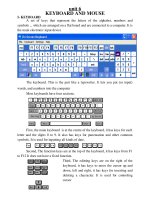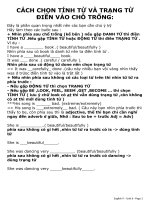marketing princiles unit 6 loyalty and relation
Bạn đang xem bản rút gọn của tài liệu. Xem và tải ngay bản đầy đủ của tài liệu tại đây (86.99 KB, 18 trang )
U it 6
Unit
Loyalty and Relationships
CuuDuongThanCong.com
/>
Objectives
• Key Concepts - Value, Loyalty, Trust
p g Loyalty
y y
• Developing
• Strategies for developing Loyalty
CuuDuongThanCong.com
/>
Recall
R
ll th
the role
l off
marketing
g
• Marketing is the delivery of customer
value
l
and
d satisfaction
i f
i
at a profit.
fi The
Th
goal of marketing is to attract new
customers by promising superior
value, and to keep customers by
delivering
de
e g satisfaction
sat s act o
Kotler et al. (2001)
CuuDuongThanCong.com
/>
Value - Key Concepts
• Value = Benefits - Cost
• And comes via:
– Product Value
– Service Value
– Image Value
• Unique Selling Proposition is the
value
l
that
h you offer
ff customers that
h
nobody else does.
CuuDuongThanCong.com
/>
•
•
•
•
•
•
•
•
•
What are the Unique Selling
Propositions of these
companies?
Sony
Vinamilk
Tiger Airways
Singapore Airways
Apple
BMW
Pizza Hut
RMIT University
Lifebuoy Soap
CuuDuongThanCong.com
/>
Basic Competitive
Strategies
• Overall cost (price) leadership
• Differentiation
• Focus
Porter (1980)
• Operational Excellence
• Operational Intimacy
• Product Leadership
Tracy and Wiersema (1993)
CuuDuongThanCong.com
/>
Value of Relationships and
Loyalty to Organisations
• Insulating customers from
competitors
• Reducing
R d i
marketing
k i
costs
• Encouraging repeat business
• Enhancing
E h
i
positive
iti
““word
d off mouth”
th”
• Potential Risks:
– Over-servicing
– Conceding Profits
CuuDuongThanCong.com
/>
Value
V
l
off Relationships
R l ti
hi &
Loyalty
y y to Customers
• Time poor
• Switching costs
• Security of sticking with the known
CuuDuongThanCong.com
/>
What is Loyalty?
• Loyalty is the willingness of someone
to make an investment or personal
sacrifice in order to strengthen a
relationship. Consequently customer
loyalty is about more than repeat
purchases. True loyalty clearly
affects profitability
Reichheld (2003)
CuuDuongThanCong.com
/>
What is Loyalty?
Loyalty
Attitudinal
Behavioural
Fullerton (2003)
CuuDuongThanCong.com
/>
What is Loyalty
Satisfaction
Commitment
Trust
Roehm, Pullins and
Roehm (2002)
CuuDuongThanCong.com
Social/Relational
Benefits
/>
Issues Impacting on
Loyalty
• Competitive intensity including
increasing alternatives
• Shifts
Shif iin power to the
h customers including consumer legislation,
education and “trained
trained behaviours”
behaviours
• Increased focus on quality and
service
• Technology and access to
information
CuuDuongThanCong.com
/>
Attitudinal & Behavioural
Loyalty
• Behavioural measures of loyalty tend to be
historical
– How recently a customer has made a purchase
– Frequency of purchases
– Volume of purchases in a specified period of time
• Attitudinal measures of loyalty measures
intentions
– Likelihood to continue doing business
– Likelihood
Lik lih d off expanding
di
business
b i
or purchases
h
– Willingness to recommend or serve as a
reference.
CuuDuongThanCong.com
/>
Developing Loyalty
• Satisfaction
– This is most important early in a relationship.
– Over time cumulative experience takes over and
the “satisfaction” with individual transactions
becomes less important (but never
unimportant).
unimportant)
• Commitment
– The accumulation of two-way investments in the
relationship, based on shared values and
identification not just the fear of switching costs
or a sense of dependence on each other.
CuuDuongThanCong.com
/>
Developing Loyalty
• Trust
– Development of a two way reliance so
that both customer and organisation
develop a sense that the other party
shares common goals, and will work to
achieve the mutual benefit from the
relationship and are willing to avoid
opportunistic behaviour.
• Social or Relational Benefits
– A sense of friendship
CuuDuongThanCong.com
/>
Strategies
St
t i ffor Retaining
R t i i
Customers & Developing Loyalty
• Shift focus from “transactional
marketing” to “relationship
marketing
marketing”
• Making good use of CRM systems
• Use technology carefully technology can collect, but not
necessarily use wisely
• Involve and educate employees at all
levels
CuuDuongThanCong.com
/>
Customer Lifetime Value
• “The amount by which revenues from a
given customer over time will exceed the
company’s
company
s cost of attracting, selling and
servicing that customer”
Quester et al. (2004)
• Focuses on the process of managing
revenue and costs over time, rather than
the profitability of a single transaction.
transaction
• Used to determine the impact of retaining
customers.
CuuDuongThanCong.com
/>
Loyalty Programs
• Reward Purchasing
• Considerations
– Potential to raise cost of operations
– Not necessarily a differentiator
– Potential consumer backlash
• Need to consider objectives
– Reward big/frequent spenders?
– Reward share of the wallet?
– Spenders over time?
CuuDuongThanCong.com
/>









